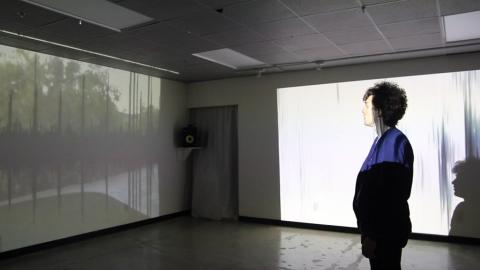The Acoustic Mapping of Bird Song Networks: Bird Song Diamond
“The intent of this project is to permit humans to understand the grammar and meaning of bird songs. Recent advances in sensor arrays, computation, and computational linguistics finally make this long-sought goal achievable.” (Charles Taylor, 2011)
Beyond developing better analytical tools, this project engages artists who are well versed in the development of art|science interface and interactive installation with sound, to establish an experience that overlays aspects of the life, loft, and language of a bird with that of human characteristics. This last investigation has broad appeal, and can serve to engage younger people to notice their environments and to participate more in scientific activities and initiatives. As an exploration into the interdisciplinary collaboration, the sonic components of the installation are composed under the auspices of the scientific team led by evolutionary biologist Charles Taylor who has been systematically categorizing bird sounds and determining the patterns of communication within spatial networks of birds in the field. Taylor also brings to the art sci team many of his collaborators, including ecologist Dr. Martin Cody, linguist Dr. Edward Stabler and physicist Dr.Takashi Ikegami and his group from the University of Tokyo. It should be noted that Ikegami has collaborated with sound artists on a number of sound installations in the past.
The new tools and methods for collecting and analyzing bird song now allow a level of observation that previously would not have been possible. We are now collecting truly vast amounts of data from previously inaccessible settings and subjecting data to previously undiscovered sophisticated structural analyses. It will be transformational to computational linguistics if the natural world beyond humans were shown to have languages that are radically different from our own (as seems quite likely). Our analysis will be aided – in fact only possible – to the extent that we can view the environment from bird’s perspective — emphasizing the important role for artists in our collaboration. A guiding theme to our research is the role of complexity and chaos in communication systems. With reference to the complexity categories studied by Wolfram and Langton, the systems we are researching are situated at the edge of chaos: their complexity is above that of fixed sequences of symbols or sounds, but below that of chaotic or purely random systems — at the phase transition between complexity categories 2 and 3. Meaning emerges and is communicated through the evolution and maintenance of intermediate complexity — patterned sequences that are simple enough to be understood, but sufficiently complex that they can carry expressive data or meaning. Among the systems whose vocalizations fall into that class are human language, and the songs of at least three species of birds that we have been studying — California Thrasher and the Cassin’s Vireos and Black-headed Grosbeak. These comprise the target species for this project; our work features field recordings and analyses unique to their songs. Supported by the National Endowment for the Arts and the National Science Foundation.
Parabolic dishes spatially separate the gallery space making two transceiving stations at opposite corners of the room. The parabolic shape is a subtle but important visual symbol to acoustic science fieldwork, which almost always involves the use of parabolic shotgun microphones. In each transceiving station there is a pair of headphones and a microphone where people can communicate and contribute to the developing language. They are invited to make a call, and join the conversation. Their sounds affect the evolution of an artificial language that is being created and replayed when there is more than 2 people joining the system. When there is only one participant the system defaults to a loop, leaving the person speaking to themselves, and the language ceases to evolve. An audiovisual organism evolves from the birdsong human-bird mimicry making grammatical structures that emerge from conversations between birdsong field recordings collected by Taylor’s group and human samples that are collected throughout the duration of the exhibition. The artificial sonic language evolves in unison with a growing diamond lattices that are projected on the floor across from one another, serving as a visual representation of evolution.
Related Art|Sci Exhibitions and Events: http://artsci.ucla.edu/birds/sculpturegarden.html
Recent papers:
A Robust Automatic Bird Phrase Classifier Using Dynamic Time-warping with Prominent Region Identification
Kantapon Kaewtip, Lee Ngee Tan, Abeer Alwan, Charles E. Taylor
http://taylor0.biology.ucla.edu/bibliography/pdf/KaewtipEtAl13ICASSP.pdf
A Sparse Representation-based Classifier for In-Set Bird Phrase Verification and Classification with with Limited Training Data
Lee Ngee Tan, George Kossan, Martin L. Cody, Charles E. Taylor, Abeer Alwan
http://taylor0.biology.ucla.edu/bibliography/pdf/TanEtAl13ICASSP.pdf
Structural Design Principles of Complex Bird Songs: A Network-Based Approach
Kazutoshi Sasahara, Martin L. Cody, David Cohen, Charles E. Taylor
http://journals.plos.org/plosone/article?id=10.1371/journal.pone.0044436


